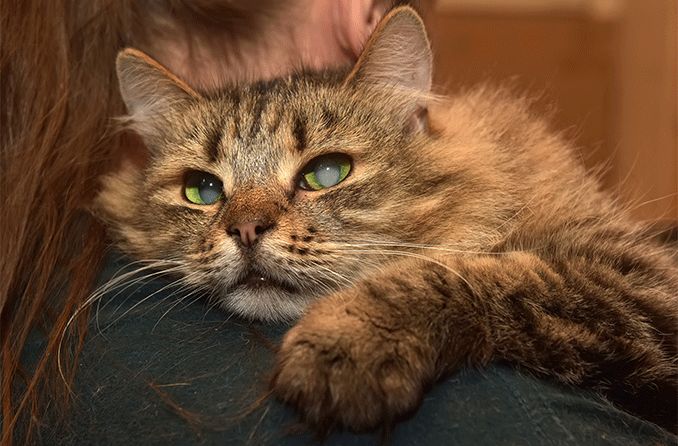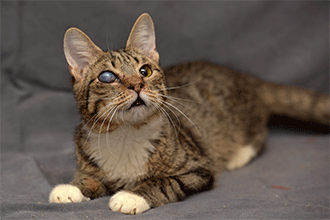Cat cataracts: Causes, symptoms, treatment and prevention

Cats are known for hiding health problems from their humans. When it comes to eye health, it's easier to tell when something is wrong, specifically when dealing with cataracts in cats. Feline cataracts are usually caused by chronic eye inflammation and can be treated with medication and surgery.
What is a cat cataract?
Cataracts in cats happen when the lens of the eye becomes cloudy or opaque. The lens of a cat’s eye works the same way it does in a human eye, by helping the eye focus on objects at different distances. It also focuses light onto the retina at the back of the eye — an important step in the vision process.
The lens is made of protein fibers. Age, inflammation and other factors can cause the fibers to clump together and create a milky film across the lens.
There are four stages of cat cataracts:
Incipient cataract – Small cataract that only affects 15% of the lens and does not hurt vision. It is possible for an incipient cataract to progress into a more serious type.
Immature cataract – Larger cataract that affects 15% to 100% of the lens. Though light is still able to pass through the cataract, it may begin to affect vision.
Mature cataract – The cataract blocks the entire lens and light is not able to pass through. Vision impairment is likely.
Hypermature cataract – Water and protein in the lens dissolve and the lens begins to shrivel up. Treatment may restore some vision in younger cats.

Cataracts should not be mistaken for nuclear sclerosis, a normal, age-related change of the lens that makes it appear white. The condition is common in pets aged 7 and older and does not affect vision.
How cataracts develop in cats varies from cat to cat. They may affect one eye (unilateral) or both eyes (bilateral). It’s also possible for them to appear and worsen quickly, or gradually develop over time. If left untreated, cataracts can result in blindness.
SEE RELATED: Anatomy and function of a cat’s third eyelid
Causes and risk factors
There are many reasons for cataract development in cats. Typically, cataracts are a result of eye inflammation caused by infection or trauma.
Common causes of cataracts in cats are:
Genetic or hereditary factors (Birmans, Himalayans and British Shorthairs may be genetically predisposed)
Eye trauma
Inflammation within the eye (iritis or uveitis)
Radiation exposure
Infection
Nutritional imbalances
Metabolic disorders, including diabetes
Cancer
High blood pressure
Lens dislocation (usually caused by trauma or inflammation)
The main risk factor for cataract development in cats is chronic eye inflammation. Classic signs of eye inflammation in cats include:
Redness
Frequent squinting or blinking
Keeping the eye closed
Excessive tearing
Mucus or pus-like eye discharge
If your cat shows signs of eye inflammation, consult with your vet on treatment options.
Symptoms of cataracts in cats
In the early stages, it may be difficult to notice cataract symptoms in your cat. In a routine exam, your vet can recognize early signs of cataracts and help you plan ways to prevent cataract progression.
In cats with more advanced cataracts, you may notice some of the following symptoms:
White or bluish-gray pupils
Sudden clumsiness, bumping into familiar objects
Pupils with a hazy appearance in certain lighting
Hiding (more than in the past)
Disorientation
Difficulty navigating the home or finding their food bowl or litter box
Caution or hesitance using stairs
Reduced agility
Behavioral symptoms of cataracts in cats may be too subtle for cat owners to notice. For this reason, it’s important to take your cat to the vet for an annual check-up and make it a habit to check your cat’s eyes for changes or irregularities. If you notice a change in color, or a haziness in the eyes, it’s best to have them examined by a veterinarian.
How cat cataracts are diagnosed
A veterinarian will examine your cat's eyes to find out whether their symptoms are caused by cataracts, or if nuclear sclerosis is to blame. If the veterinarian thinks your cat has cataracts, they may send you to a veterinary ophthalmologist.
A veterinary ophthalmologist focuses on eye conditions that affect animals. They will run a series of tests to confirm cataracts and find the cause.
These tests include:
Ultrasound imaging to look for problems in the retina, located at the back of the eye
Blood testing to check for infection, inflammation and metabolic disease
Urine tests to check kidney, liver and pancreas function
Testing your cat's eye pressure
Electroretinogram, which tests how well the retina is functioning with the cataract
Treatment for cataracts in cats
Once your vet makes a diagnosis and finds the underlying cause, you can start looking at treatment options. The best treatment for your cat depends on what caused the cataracts and how far the cataracts have progressed, along with your cat’s age and overall health.
Cataract surgery
The most common and recommended treatment for feline cataracts is cataract surgery. During surgery, a surgeon will make tiny incisions using a microscope. The incisions will likely be in the cornea and in the lens capsule.
The surgeon will insert a special instrument into the incision that uses high-frequency sound to break up the cataract. Once disintegrated, they will remove the affected lens and replace it with an artificial lens. The incisions will be stitched up and your cat will be good to go.
The procedure takes around an hour to complete and is usually successful in kittens and mature cats who are in good health.
After surgery, your cat must wear a recovery cone to allow for proper healing and prevent your cat from scratching their eyes accidentally. For three weeks, you must keep your cat in a confined space and watch for possible complications, such as bleeding or swelling. You’ll also have to apply topical medicine to your cat’s eyes for a few months after surgery.
Medication
Depending on what’s causing the cataract, certain medications may be able to help.
Steroids and non-steroidal eye drops can reduce inflammation. Medicated eye drops can also help treat viral and bacterial eye infections. Applying prescribed eye drops can make your cat more comfortable, though they do nothing to treat the actual cataract.
The goal of eye drops is to control inflammation within the eye. Persistent inflammation can lead to feline glaucoma. Feline glaucoma does not respond well to treatment and often requires eye removal.
Eye removal surgery
Surgery to remove the eyeball, called enucleation, is usually done as a last resort, but may be required. It depends on the underlying cause of the cataract, the severity of swelling and how much pain the cat is experiencing.
Though eye removal seems traumatic to humans, cats often adapt well to having only one eye.
Ways to prevent cataract development in cats
There are some causes of cataracts in cats, such as age, that cannot be prevented. However, there are a few steps you can take to reduce the chances of cataracts developing in your cat. You can:
Schedule regular veterinary visits.
Keep your cat’s vaccinations up to date.
Prevent your cat’s exposure to unfamiliar cats and potential eye trauma by keeping your cat indoors.
Check your cat’s eyes routinely for irregularities.
Treat any underlying health issues in your cat, such as diabetes and high blood pressure.
READ MORE about cat vision
Cataracts in cats. Animal Medical Center. Accessed September 2021.
Cataracts in cats: What you need to know. Hill's Pet. October 2020.
Cataracts in cats. Pet Health Network. May 2014.
Feline cataracts. Cornell University College of Veterinary Medicine. Accessed September 2021
Cataracts in cats. Veterinary Centers of America. Accessed September 2021.
Eye inflammation in cats. Pet Health Network. Accessed September 2021.
Page published on Wednesday, October 13, 2021
Medically reviewed on Monday, October 4, 2021






